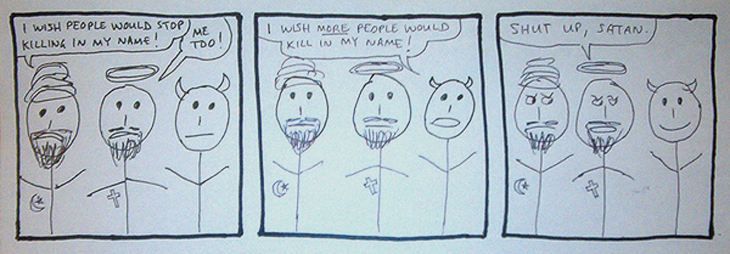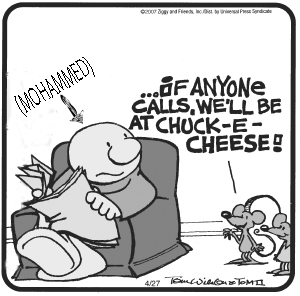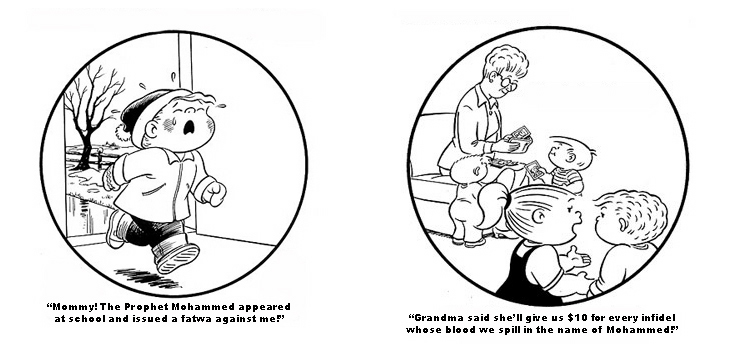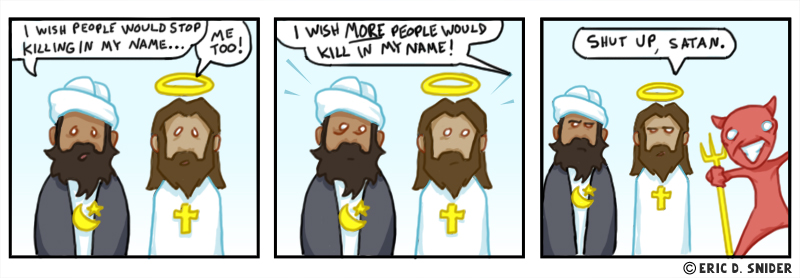As you know, there is no greater issue facing the world today than the matter of cartoons. Who draws them? Are the cartoons funny? Do they depict images of holy personages and thus prompt violent reprisals? Why does Garfield like lasagna so much? All of these questions are important.
I’ve always thought cartoons were a serious matter, certainly worth committing murder and setting fires, and I’m glad the rest of the world has finally caught up with me. In recent weeks, European newspapers have been taken to task for publishing political cartoons that included drawings of Mohammed and which suggested modern Islam is sometimes a wee bit violent and radical. Outraged by these allegations, Muslims have responded by killing people.
Man, you know the world is crazy when even a straight summary of the news sounds like a joke. (See also: “The vice-president shot a lawyer.”) Technically, what the Muslims — and not all of them, just the crazy ones — have been rioting about is that in their view, ANY depiction of Mohammed, even a flattering one, even taken from his good side with him smiling like a matinee idol, is blasphemy. They seem to have ignored the actual CONTENT of these cartoons, missing the fact that by lashing out, they’re proving the cartoons’ point. That, or they’re oblivious to irony.
Some moderate Muslim writers have observed that while the Koran might forbid drawings of the Prophet, that rule doesn’t apply to non-Muslims any more than the rule against eating pork applies to non-Jews. But others say that since Muslims consider the likeness of the Prophet to be sacred, non-Muslims should refrain from depicting him out of respect.
Westerners are thus caught in a difficult position. On the one hand, we agree with the idea of respecting other people’s religions. But on the other hand, we think the policy against showing pictures of Mohammed is stupid. (You can’t even draw a PICTURE of your guy?! Why the freak not?!) We can’t just come out and say that, though. The newspaper editorialists can’t say, “We uphold the Danish papers’ right to publish those cartoons, largely because we think the ‘no drawings of the Prophet’ rule is silly.” That would just fan the flames.
There’s even some debate over whether depictions of Mohammed really ARE forbidden by the Koran, and I have no way of finding out a definitive answer. Even if I read the Koran — which is unlikely, given that I’m still working on “The Five People You Meet in Heaven” — I suspect that if it’s anything like the other works of scripture I’m familiar with, there are many passages that can be interpreted in a variety of ways. For all I know, the part about Mohammed pictures could also be interpreted to mean, “Kill anyone who DOESN’T draw pictures of the Prophet.” I’m no Islam scholar.
If drawings of the Prophet are forbidden, though, how good a drawing does it have to be for it to count? Does it have to really look like Mohammed? How does anyone even know what he looks like, considering there weren’t cameras when he was alive and no one’s allowed to draw him? Does this cartoon, which I drew and which has an all-star cast of religious figures, qualify as blasphemy, even though it’s just stick figures?

What if a lazy cartoonist merely SAYS a character is Mohammed, and puts forth no effort to achieve a good likeness, as in the following “Ziggy” comic?

Theologians may discuss these questions for years, or until they are murdered by extremists, whichever comes first. In the meantime, let’s enjoy two “Family Circus” cartoons that parody radical Islam without using the Prophet’s image. Leave it to Bil Keane (and occasionally his son Billy, who fills in some weeks) to show us the way.

Those are the actual cartoons, by the way, the way they originally appeared in newspapers, completely unaltered by me. You can trust me on that. The Koran forbids lying. (I think.)
In 2014, a reader named Dave contributed a more professional version of my comic strip:

I am not still working on "The Five People You Meet in Heaven," by the way. I started it a couple years ago and quit because it was just too, too cheesy. I cited it here because I wanted a book title that would call to mind superficial, fluffy literature -- the antithesis of the Koran, in the other words -- and "The Five People" fit the bill nicely.
At BYU, I took a class called "Islam and the Gospel," "the Gospel" being Christianity in general and Mormonism specifically. This was pre-9/11; I imagine the class feels even more urgent and relevant (not to mention crowded) today. Sadly, I remember very little from the course, apart from a few vocabulary words.
Up until May 3, 2007, I had a Far Side comic instead of a Ziggy, employing the same joke. It was the one called "Inconvenience stores," where everything is on a really, really high shelf, and a little kid is looking up at it. I labeled the kid "(MOHAMMED)." But on May 3, 2007, I got a cease-and-desist e-mail from Gary Larson's lawyers! My first C&D ever! It read as follows:
Dear Mr. Snider:
Creators Syndicate, an international newspaper syndicate, syndicates Gary Larson's The Far Side cartoons to foreign newspapers. In addition we handle all reprint permissions requests for The Far Side following guidelines long established by Mr. Larson and his company FarWorks Inc. (copyright owner to all Far Side images). In short, we approve or disapprove requests to reproduce Mr. Larson's cartoons, and carefully monitor the ways in which they appear.
We are writing on behalf of FarWorks, Inc. and Gary Larson about your posting of one Far Side cartoon on your website https://www.ericdsnider.com/snide/jihad-to-be-you/. While Mr. Larson is certainly flattered to know you are a fan of his work, we have to be concerned about any unauthorized use of The Far Side name and cartoons, especially when they appear online. We must be particularly concerned when, as is the case on your site, the copyrighted material has been altered so that its meaning is significantly different from that intended by its author.
FarWorks has a serious problem with unauthorized uses of The Far Side worldwide. As a result, it does not allow online publication of works from The Far Side. No matter how insignificant a few uses may seem, it still amounts to making versions of the cartoons available in digital form for anyone to download, which makes it virtually impossible for Mr. Larson to control future uses, something that is very important to him.
Please read the letter from Mr. Larson below, and respect his wishes by removing the cartoon from your website. Many thanks in advance for your cooperation.
Sincerely,
Andrea Fryrear
Permissions Department
Creators Syndicate
5777 W. Century Boulevard, Suite 700
Los Angeles, CA 90045
Attached was, indeed, a form letter from Gary Larson himself:
TO WHOM IT MAY CONCERN:
I'm walking a fine line here.
On the one hand, I confess to finding it quite flattering that some of my fans have created web sites displaying and / or distributing my work on the Internet. And, on the other, I'm struggling to find the words that convincingly but sensitively persuade these Far Side enthusiasts to "cease and desist" before they have to read these words from some lawyer.
What impact this unauthorized use has had (and is having) in tangible terms is, naturally, of great concern to my publishers and therefore to me -- but it's not the focus of this letter. My effort here is to try and speak to the intangible impact, the emotional cost to me, personally, of seeing my work collected, digitized, and offered up in cyberspace beyond my control.
Years ago I was having lunch one day with the cartoonist Richard Guindon, and the subject came up how neither one of us ever solicited or accepted ideas from others. But, until Richard summed it up quite neatly, I never really understood my own aversions to doing this: "It's like having someone else write in your diary," he said. And how true that statement rang with me. In effect, we drew cartoons that we hoped would be entertaining or, at the very least, not boring; but regardless, they would always come from an intensely personal, and therefore original perspective.
To attempt to be "funny" is a very scary, risk-laden proposition. (Ask any stand-up comic who has ever "bombed "on stage.) But if there was ever an axiom to follow in this business, it would be this: be honest to yourself and -- most important -- respect your audience.
So, in a nutshell (probably an unfortunate choice of words for me), I only ask that this respect be returned, and the way for anyone to do that is to please, please refrain from putting The Far Side out on the Internet. These cartoons are my "children," of sorts, and like a parent, I'm concerned about where they go at night without telling me. And, seeing them at someone's web site is like getting the call at 2:00 a.m. that goes, "Uh, Dad, you're not going to like this much, but guess where I am.
I hope my explanation helps you to understand the importance this has for me, personally, and why I'm making this request.
Please send my "kids" home. I'll be eternally grateful.
Most respectfully,
Gary Larson
Now, it's possible that a court might construe my use of the comic as a parody and therefore allowable. However, parody generally means creating something new that is merely similar to something else, as a means of spoofing it. But what I had done didn't involve any "creating"; it's the actual, original Far Side comic, and I've merely added a word to it. Had I re-drawn a Far Side myself -- even one made to look very similar to the original -- I'd have been fine. But that wasn't the case, and it wasn't worth fighting over, and Larson and his lawyers were polite enough about it, so I replaced it with a Ziggy in the hopes that Ziggy's lawyers are less diligent then Gary Larson's.
My use of the Family Circus panels is equally infringe-y, but so far neither Bil Keane's lawyers nor his son Billy's lawyers have contacted me.




